How To See Camera Settings In Photoshop
With a photo that'southward just a little too bright, Photoshop is here to salvage the twenty-four hour period by offer several simple image darkening tools. Whether you need to darken your unabridged photo, a single layer, or only target a specific area, Photoshop makes information technology easy. With the tips outlined below, you'll be able to correct your vivid photos in no fourth dimension.
To darken an paradigm in Photoshop, get to Epitome > Adjustments > Exposure to create a new Exposure Adjustment Layer. In the dialogue box that appears, movement the "Exposure" slider to the left to darken your photo. This will darken your entire image at once and correct any overexposed areas.
Depending on the exact concealment adjustment you want to perform, there are a few dissimilar ways to do it. Let's get into the specifics and get you lot up to speed on the all-time ways to darken images in Photoshop.
3 Piece of cake Tools For Darkening Images In Photoshop
There are a ton of unlike ways to make these adjustments in Photoshop. To avert overwhelm, permit's focus on the three near of import ones. The three aligning methods below are the fastest and easiest to utilise, no thing your ability levels.
one. The Exposure Adjustment Layer
The exposure adjustment layer allows you to control your epitome's overall exposure (aka brightness) with a single slider. For images with blown-out highlights, this is a great tool to apply.
There are a couple of different means you can create an Exposure Aligning Layer depending on your preferences. The first way is by going to your Adjustments Panel and selecting the Exposure Adjustment icon.
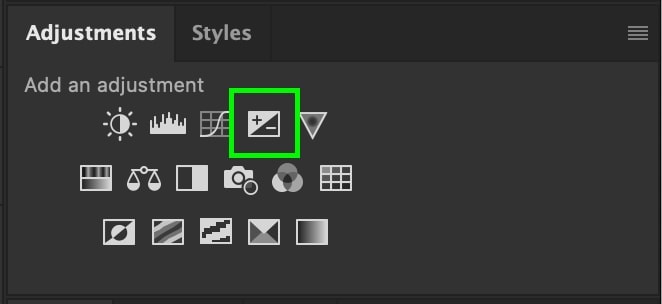

If you don't run into this panel, go up to Window > Adjustments.
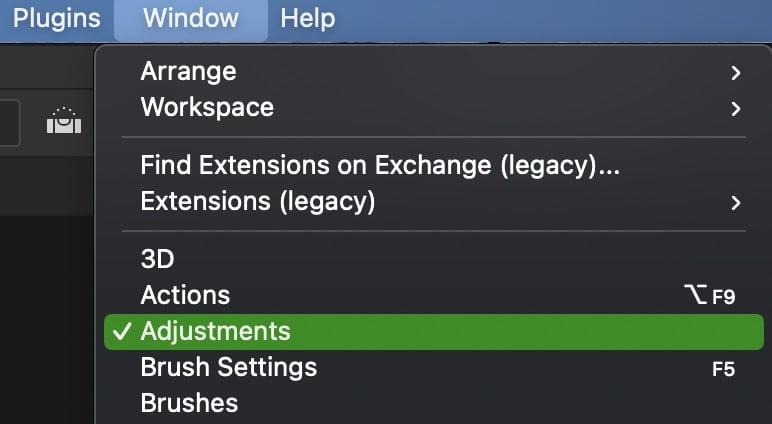
You tin achieve a similar result by going to Image > Adjustments > Exposure to create a new exposure adjustment.

The difference with this style is that yous will not accept an Exposure Aligning Layer created later. Instead, the darkening aligning volition apply directly to your paradigm, making information technology uneditable.
Since it's always nice to work non-destructively and have the option to refine adjustments, the aligning panel method is more favorable.
Regardless of which method you lot used, a dialogue box will announced with 3 different sliders chosen:
- Exposure
- Commencement
- Gamma Correction

The Exposure slider will control the overall brightness or darkness of your photo. Since we're talking about concealment images in Photoshop, that means you'll move the Exposure Slider left.
Equally y'all move this slider farther left, your image volition become increasingly dark. Depending on how bright your photo was to begin with, the right setting will vary.
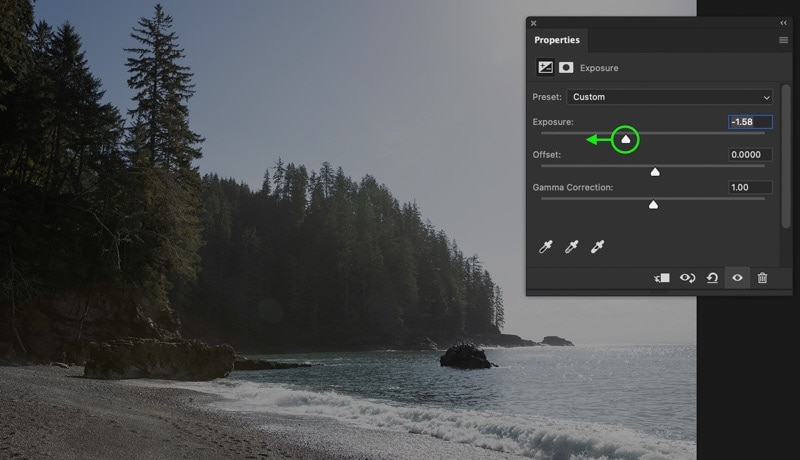
After the exposure aligning, y'all're left with the First and Gamma Correction sliders. The First slider will elevator or lower the base of operations indicate of your shadows. Past increasing this slider, your image will take on a matte advent while taking on deeper shadows when decreased.
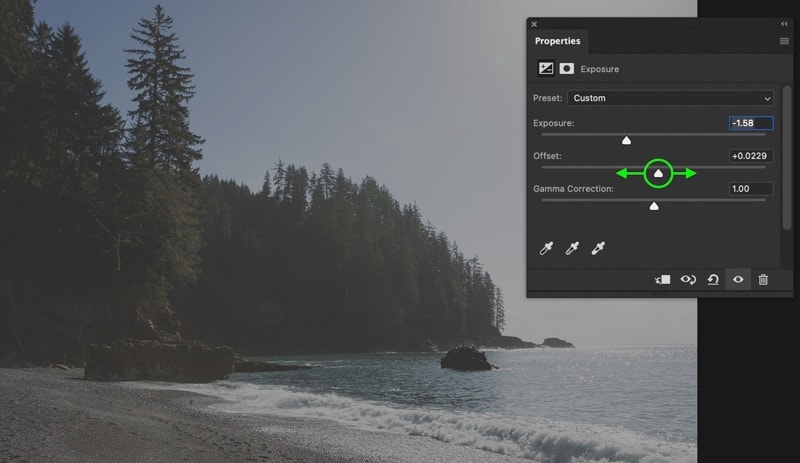
Meanwhile, the Gamma Correction slider offers further command to the brightness of the mid-tones. By adjusting this slider, you can burnish or darken the middle exposure values to further refine your darkening adjustment.
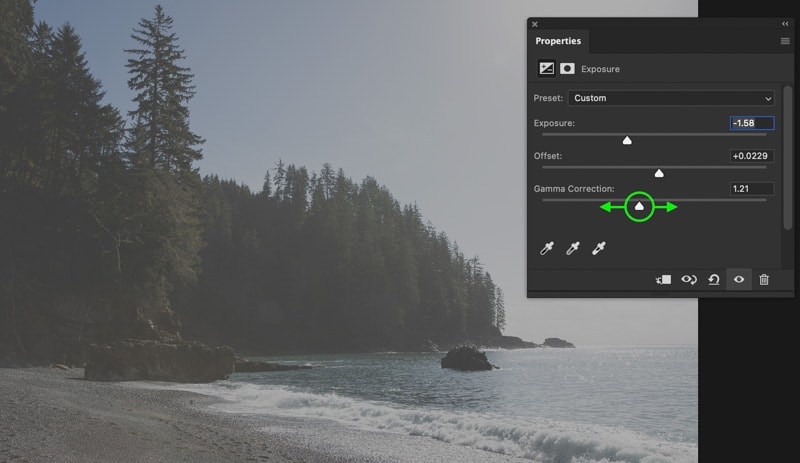
The Starting time and Gamma Correction sliders are more than helpful additions rather than necessary tools. If you just want to make a quick darkening adjustment to your photo, decreasing the Exposure Slider will practise the pull a fast one on. The other sliders just offer an easy fashion to improve your exposure farther if needed.
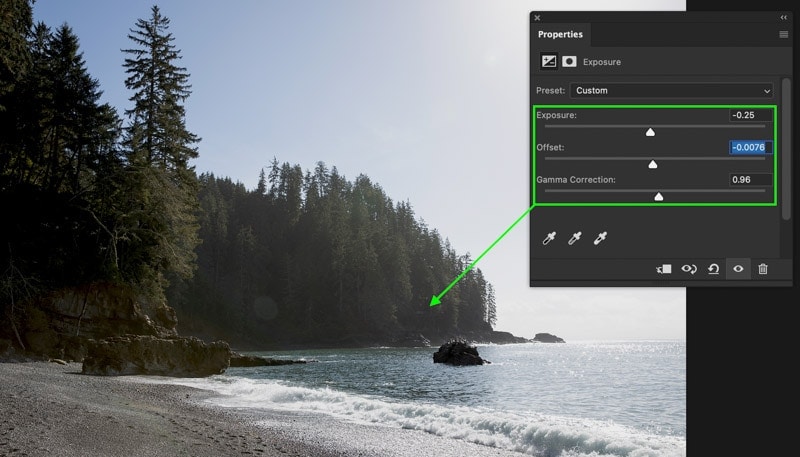
ii. Photographic camera RAW
For those who already feel comfy in Lightroom, darkening images in Camera RAW volition feel right at abode. Photographic camera RAW is a tool inside Photoshop that allows you to process RAW files before bringing them into the main workspace. When opening a RAW file directly from your computer, Camera RAW will open automatically, making it simple to access.
Even if yous aren't working with a RAW file or have already opened your photo in Photoshop, Camera RAW is like shooting fish in a barrel to admission.
With your paradigm layer selected, go to Filter > Photographic camera RAW Filter to open up Photographic camera RAW.
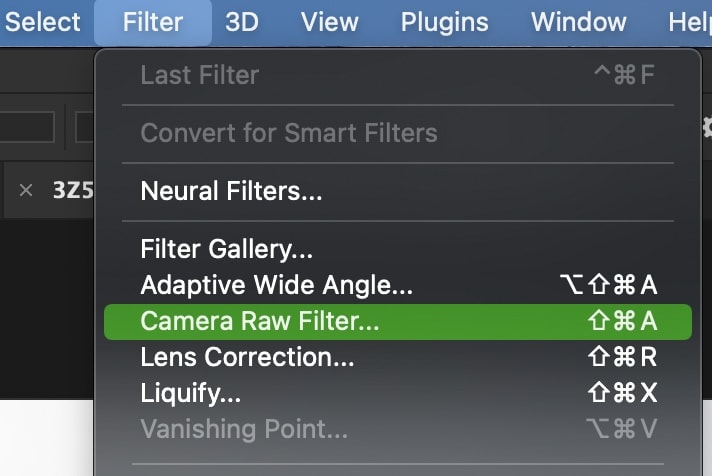
Once inside, make sure you're in the Basic Panel and expect for the Exposure Slider. By dragging this to the left, you tin darken your entire photo at once.
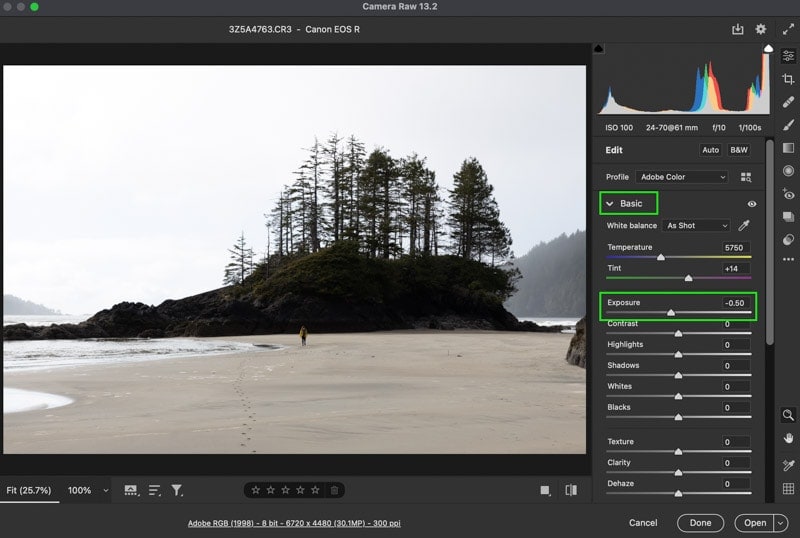
In many cases, yous may only want to darken the brighter parts of your photo. Things similar an over-exposed sky or the highlight on someone's face up. In this situation, the whites and highlights sliders show useful as well.
Using either one, you lot'll only darken the brightest parts of your photo, leaving the shadows untouched. This is a peachy way to refine your darkening adjustments without crushing the shadows.
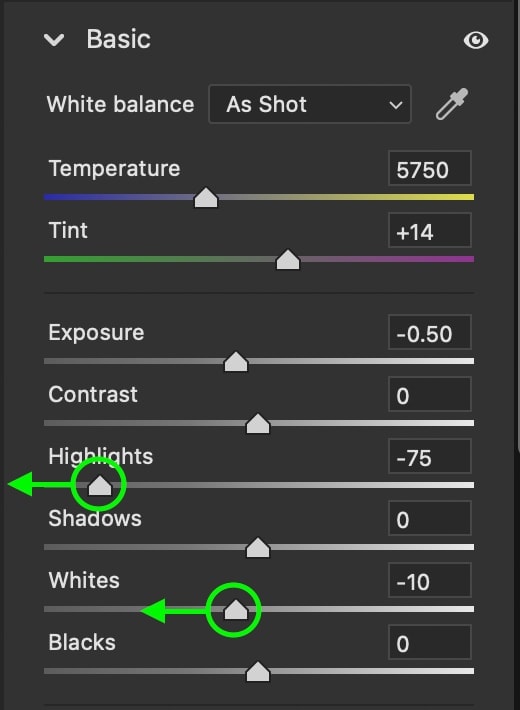
One time you lot're happy with the adjustment, press OK or OPEN to get out Camera RAW.
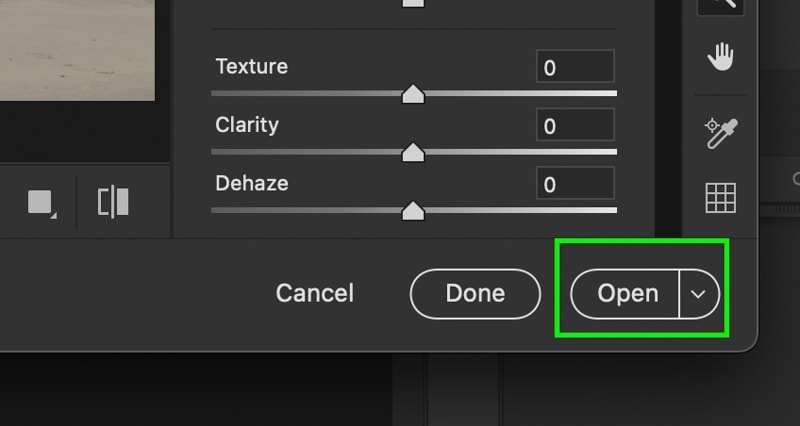
Past default, Camera Raw volition apply all your adjustments directly onto your layer. That means you cannot go back to refine your adjustments later on. Luckily, there is a workaround to this with the assistance of smart objects!

If y'all want the option to edit your Camera RAW Filter afterwards on, beginning convert your layer to a smart object by right-clicking > Convert To Smart Object.
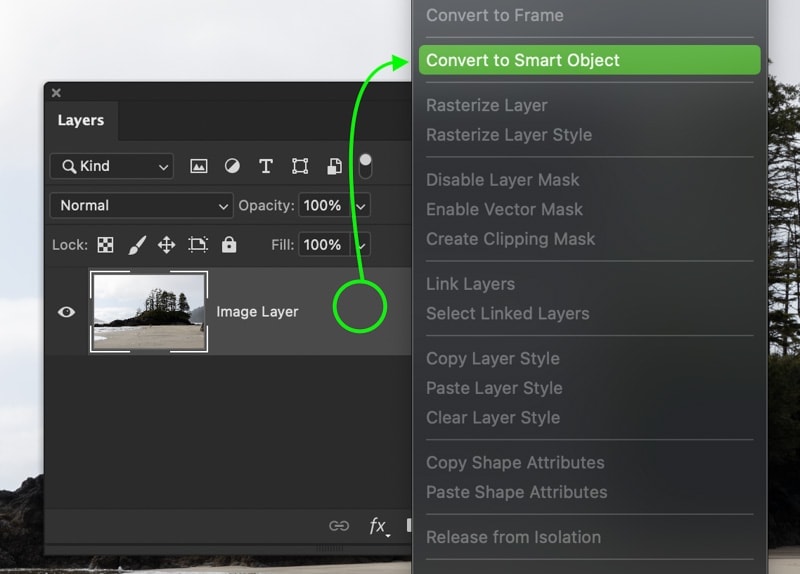

From there, yous tin can follow the same steps equally before (Filter > Camera RAW Filter) and make your adjustments. This time, once you've exited Camera RAW, it will exist attainable below your layer.
If you desire to become back to your adjustments, just double-click on the filter to gain access.
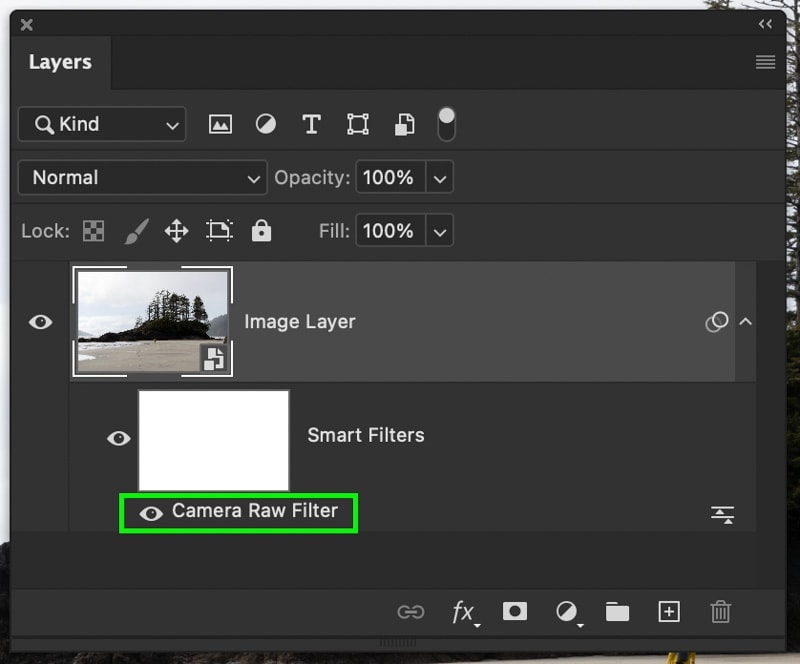
Yous tin can learn more than most smart objects and why they're useful here.
3. The Brightness & Contrast Adjustment Layer
Now for the 3rd way to darken an paradigm in Photoshop comes the Brightness & Contrast Aligning Layer. This is the virtually simple to employ darkening adjustment equally information technology only has two sliders to piece of work with. If you want to darken a photograph in Photoshop quickly, this adjustment layer offers some other not bad option.
First, create a new Brightness & Dissimilarity Adjustment layer by clicking on the icon in the Adjustments panel. This will create a new aligning layer in your layers panel, assuasive you to edit non-destructively.

Alternatively, yous can go upwards to Image > Adjustments > Brightness/Contrast. With this method, the adjustment volition be directly applied to your image or layer. So only do this if you know you'll be certain with the adjustments you make!

Regardless of how you create the aligning layer, a dialogue box will announced, offer y'all 2 different sliders: Effulgence and Dissimilarity.
The brightness slider will control the overall exposure of your photo.
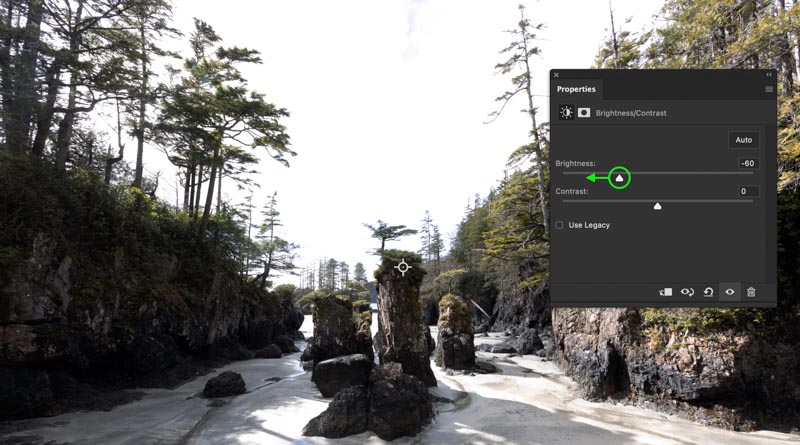
The contrast slider controls the intensity of your highlights and shadows.
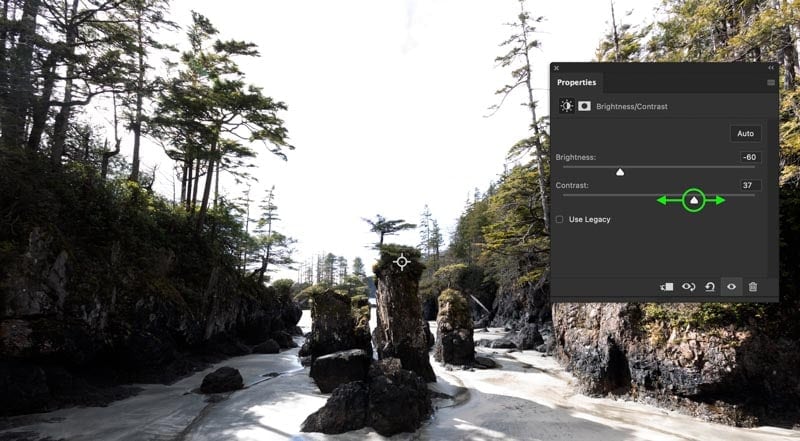
To darken your photo, motion the brightness slider to the left. One time your photo is darkened, y'all can play around with the contrast slider to heighten the darkening adjustment. For a more moody expect, effort increasing the contrast!
How To Darken A Layer In Photoshop
To darken a layer in Photoshop, create a new Brightness & Dissimilarity Adjustment Layer above the layer you want to darken. In the dialogue box that appears, elevate the Brightness slider leftwards, then press Command/Control + Option/Alt + G to create a new clipping mask. At present your darkening adjustments will only be visible on the layer directly below the Brightness & Contrast Adjustment Layer.
In Photoshop, all adjustment layers will apply to the unabridged canvas past default. That ways a darkening adjustment would be applied to all layers below the concealment aligning in the layers panel.
To make your aligning only target a certain layer, you'll need to use something called a clipping mask.
Of the three darkening tools yous learned virtually previously, but the exposure adjustment and the brightness & dissimilarity adjustment will work with a clipping mask. That'southward because clipping masks only work with adjustment layers.
In this instance, let's darken this layer with an exposure aligning. I'll showtime by clicking on the exposure adjustment icon in the Adjustments panel.

If y'all don't see this panel, become to Window > Adjustments.
And so brand sure the exposure adjustment layer is above the layer you lot want to target.
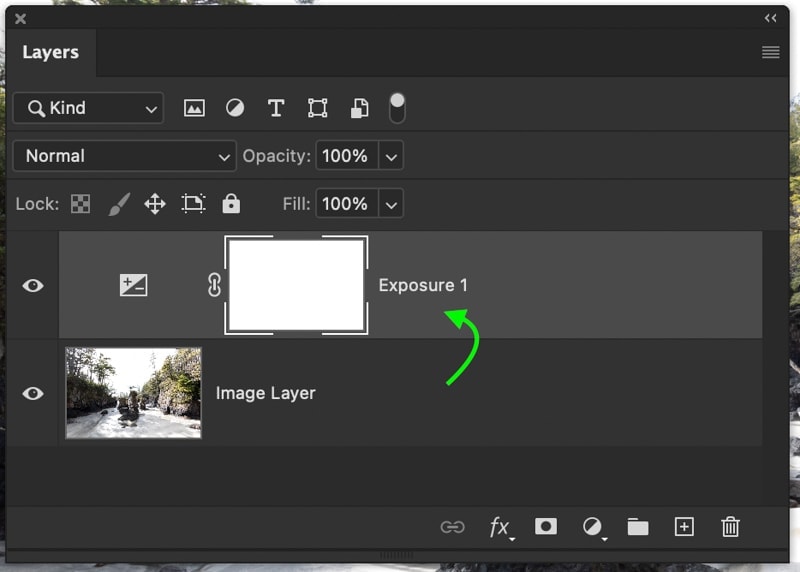
Once the exposure dialogue box appears, click on the clipping mask icon to create a new clipping mask.
Alternatively, you can printing Command + Pick + Grand (Mac) or Command + Alt + G (PC) to create a clipping mask.
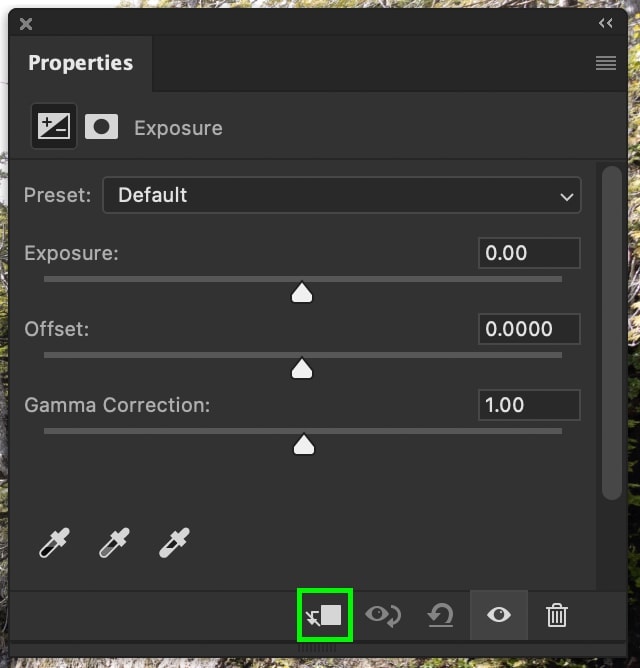
At present the exposure aligning will have a right-angle arrow icon indicating a clipping mask. When you brand changes to the exposure adjustment layer, the effects will only be applied to the layer it's clipped to.
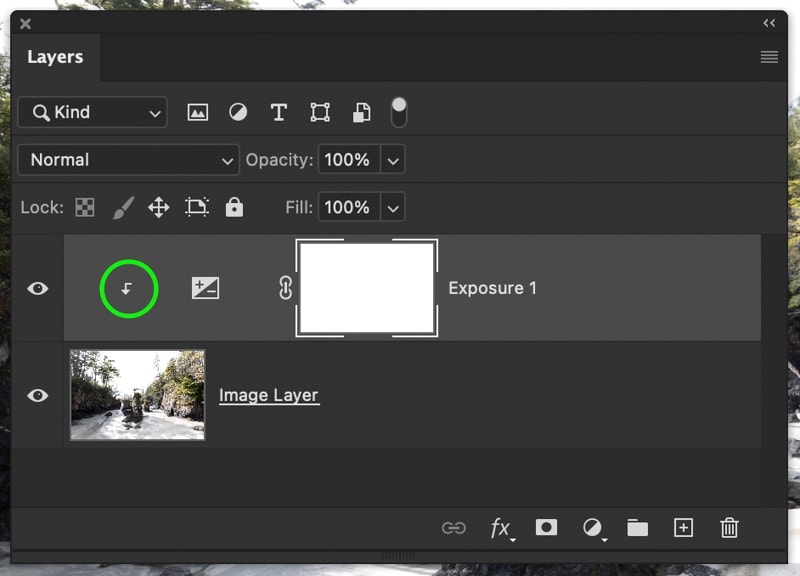
Clipping masks can be used with any adjustment layer in Photoshop and are perfect for adding concealment adjustments to one layer. To get a better idea of all the ways you can use clipping masks in Photoshop, cheque out this postal service!
How To Darken Part Of An Image
To darken part of an image in Photoshop, first, create an Exposure Adjustment Layer and place it at the top of the Layers Panel. Next, access the Castor Tool (B) and gear up black to your foreground color. With the Exposure Aligning layer mask selected, paint over your image to hide the darkening adjustments every bit needed. Now you're left with concealment adjustments simply visible in parts of your photo.
Layer masks let you to make your adjustments just show upwards in certain areas. With the help of the Brush Tool, yous tin can paint over your image to tell Photoshop exactly what y'all want to edit. For something like concealment part of an epitome, layer masks are the perfect tool for the job.
Once more, the easiest style to do this is by using aligning layers. Although you can create masks in Camera RAW, it's a more than circular-nearly way of doing things. That'southward why I suggest using the Exposure or Brightness & Contrast adjustment layers instead.
For example, allow's create a new Effulgence & Contrast adjustment layer.

By default, it will appear in your layers panel with a white box beside the layer icon. This is your layer mask!
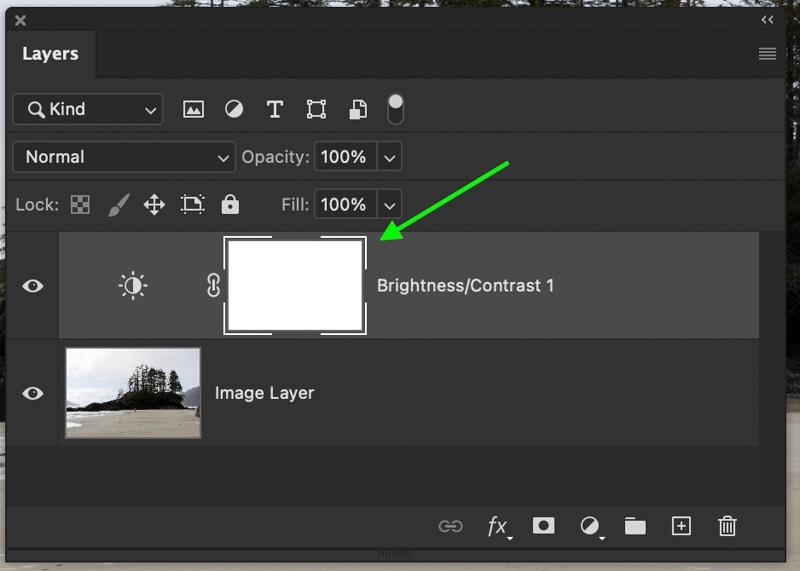
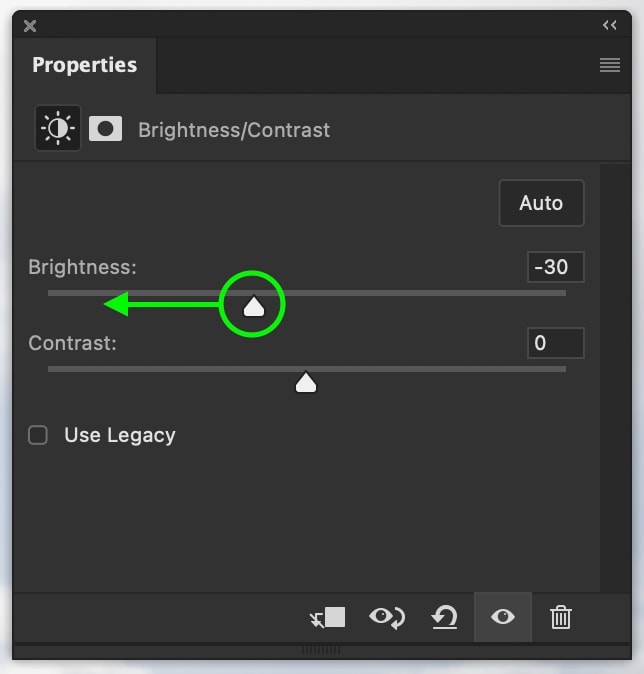
Every aligning layer y'all create in Photoshop volition automatically have a layer mask created for the layer.
How convenient is that?
When the layer mask is white (100% visible), that means every part of your image will be affected past your adjustment layer. To brand certain areas transparent, you need to pigment black onto the mask.
To do this, select your Brush Tool (B) and set your foreground colour to black.
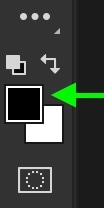
First, make certain your layer mask is selected by the white outline. Then begin to paint over the areas of your photo yous don't desire to exist darkened.
Once you lot're finished, the darkening adjustments will only exist visible in the white areas of your mask.
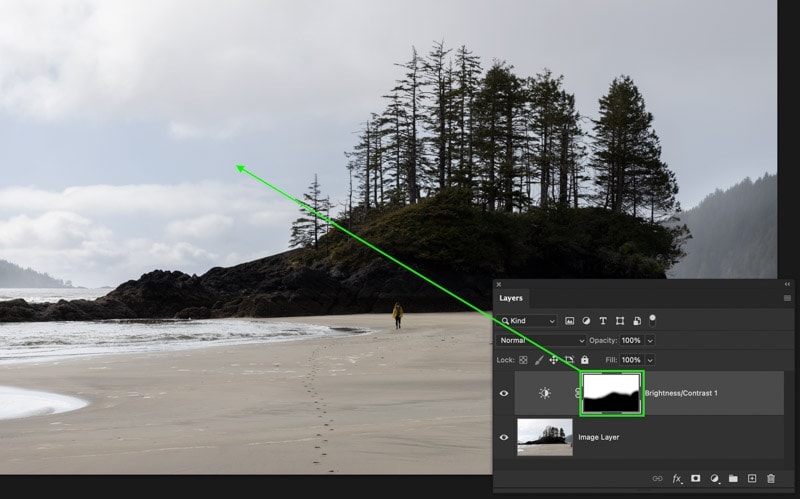
Since I wanted to darken the sky, y'all tin can come across that the white area of my mask matches up with the upper department of my image.
Now you've successfully darkened role of your photograph with the help of a layer mask! Layer masks are 1 of the most valuable tools in Photoshop and tin be used in countless different ways. If you're not familiar with them yet, I highly propose checking out this post on the uses of masks!
How To Darken Part Of A Layer
Especially when you're working with cutouts and merging multiple images, you may want to darken function of a certain layer. Rather than using your brush tool and a layer mask to perfectly mask around the edge of something, yous tin utilize a clipping mask to help with the procedure.
For this instance, I take a cutout of a person that I want to darken a portion of. First, I'll create a Brightness & Contrast adjustment layer.

With the aligning layer created, I'll create a clipping mask to target the cutout layer.

At present I'll apply my concealment adjustment as needed. Bringing downwards the Brightness slider and and so adjusting the Contrast every bit necessary.

Because of the clipping mask, all of these darkening adjustments are simply affecting the cutout layer. To further refine this area, you can employ a layer mask.
With the Brightness & Contrast aligning layer mask selected, I'll grab the Brush Tool (B) and gear up the foreground color to blackness.

Now painting over the cutout, I tin mask out any sections that I don't want to darken. Using a clipping mask and layer mask together, you get the ultimate control for your darkening adjustments in Photoshop!

How To Darken Text In Photoshop
To darken text in Photoshop, select your text layer and then open the Graphic symbol Console. If you don't see this panel, get to Window > Character. Within the Character Panel, click on the "Colour" box. In the color picker that appears, select a darker version of your electric current text color and click OK. Now the darker color will exist practical to your text.
With that said, whether you have an editable text layer or have text broiled into your photo, there are a couple of different ways to darken it.
– Darkening A Text Layer
If you're working with a text layer, the easiest way to darken it is past just changing the color. This is apace washed with the assistance of the Character Console.

First, make certain your text layer is selected in the layers panel, and then open up the Character panel.

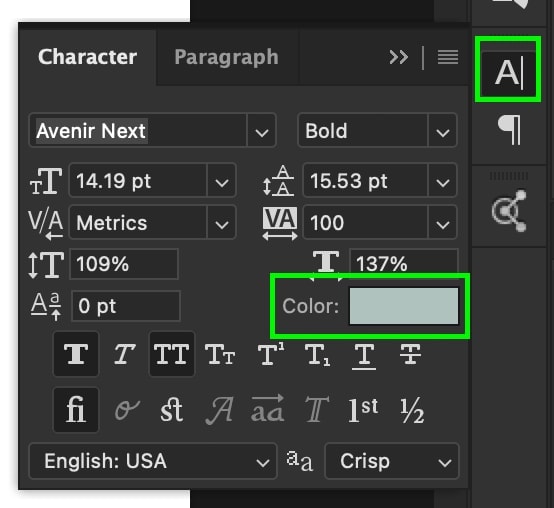
If yous don't meet this, get up to Window > Character.

Inside the Character panel, click on the "Color" box. From the colour picker that appears, select a darker color than your initial text. Since I had a light turquoise color earlier, I'll motion the color picker to a darker tone and click OK.

Your newly selected color will be practical to your text, and you're left with a darker color than before!

– Concealment Text That's Broiled Into Your Photograph
In some cases, yous may have text that is directly applied to your photo. That means at that place isn't any editable text layer to work with. Instead, you'll demand to apply a Hue Saturation Aligning Layer to darken the luminance of your text color.

Commencement, create a new Hue Saturation adjustment layer by clicking on the icon in the Adjustments panel.

In this example, the text nosotros are working with is cyan, which means we'll need to target the cyan color range. In the Hue Saturation dialogue box, I'll ready the colour aqueduct from Master to Blues.
If y'all have a unlike text color, select the related color channel for your adjustment.
At present click on the Lightness slider and drag information technology to the left. This will darken the cyan tones in the image, in turn, darkening the text.

By targeting the specific color range, yous're able to darken the color of your text without whatever selections. This method offers a very simple manner of doing things when you don't have a text layer to work with.
How To Darken Sunlight In Photoshop
To darken sunlight in Photoshop, create a new Curves Aligning Layer and then add anchor points to the shadows and mid-tone areas of the curve. With the anchor points fix, add a tertiary anchor point in the highlights and elevate it down to darken. This will only darken the highlights in your image and, in turn, darken the sunlight in your photo.
To start, create a new Curves Adjustment layer to a higher place your image layer.

In the dialogue box that appears, begin past creating ii anchor points in the shadows and mid-tones sections. The goal here is to add the anchor points without moving the curve in any fashion. This style, you tin can isolate the highlight exposure range without affecting the remainder of your photo.

Once complete, add another anchor point in the highlights department. This fourth dimension click and elevate this anchor indicate down to darken the highlights. This will darken the brighter areas of your photo and works well to darken sunlight in Photoshop.
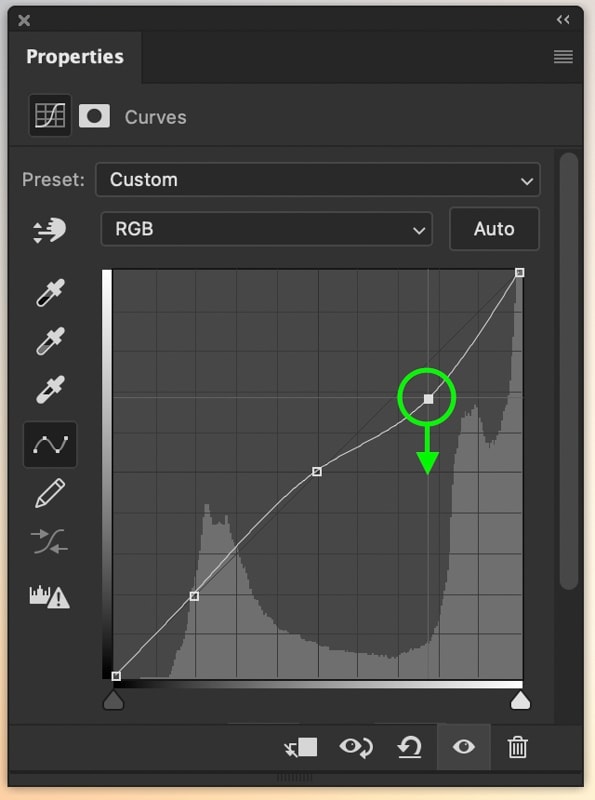
In some cases, y'all may need to bring downwards the mid-tones anchor point slightly as well.
Afterwards some quick adjustments, y'all've successfully darkened the sunlight in your photo with the assistance of the Curves Aligning! You can mix this adjustment with any of the 3 concealment adjustments mentioned previously for fifty-fifty more refined effects.
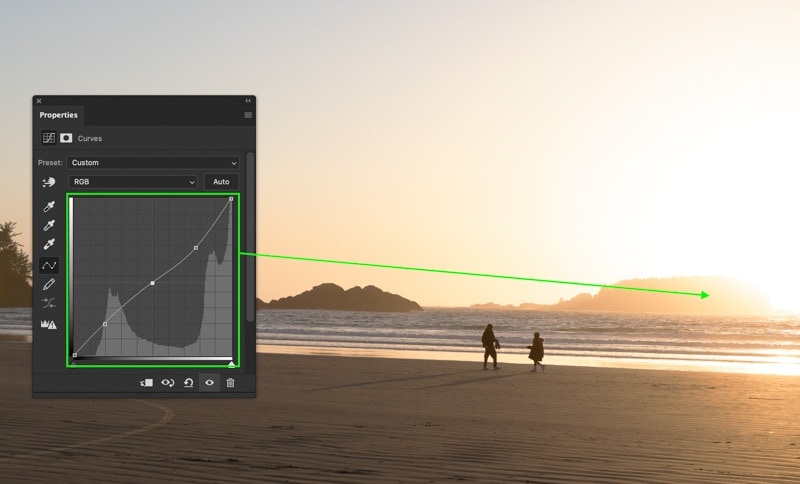
How To Ready Overexposed Photos In Photoshop
To set up overexposed photos in Photoshop, select your prototype layer, then go to Filter > Photographic camera RAW Filter. Inside Camera RAW, bring down the Exposure Slider to balance out the brightness. Next decrease the Highlights and Whites Sliders to bring back details and set whatsoever overexposed areas. Once complete, click OK to salvage your changes and exit Camera RAW.
If you lot have a totally overexposed photo, and none of the methods and so far have washed the trick, Camera RAW offers a refined mode of fixing this. Using the highlights, shadows, whites, and blacks sliders, you can apace fix a bright photo.
Start by selecting your image layer, right-clicking on information technology, and selecting Convert To Smart Object.

Then go up to Filter > Camera Raw Filter.

Inside the Basic panel, yous'll find all your key exposure adjustments. Although you lot could eyeball your exposure until it feels less bright, the histogram will offer exact feedback. Then before making whatsoever adjustments, click on the Highlight Clipping Warning option in the histogram.
With this option enabled, any areas of your photo that are too bright will show a cherry highlight. The goal now is to suit your sliders until all the scarlet highlight has disappeared.

The easiest way to brainstorm is by darkening the Exposure slider to darken the whole photo. Bring this downwards to where the photograph is darker, but nothing in the photo has become too nighttime and difficult to see.
Now bring down the Highlights and Whites sliders to bring back the information in the brighter areas of your photo. Every photo will require something unlike, so play effectually with these sliders to see your options.

Finally, adjust the Shadows and Blacks sliders to suit your style. By increasing these sliders, you lot'll burnish the dark parts of your photo and create a more than matte appearance. By decreasing them, y'all'll add together dissimilarity to your paradigm and deepen the shadows.

Once you're happy with the adjustments, click OK to save your changes.

Camera RAW will close and be saved as a smart filter beneath your layer. It can be reaccessed at any time by double-clicking on the words "Camera RAW" beneath your layer.

Now y'all've successfully fixed an overexposed epitome in Photoshop, score!
How To Darken A Face In Photoshop
To darken a face in Photoshop, create a new Effulgence & Contrast Adjustment layer and move the Effulgence slider leftward. Clicking on the aligning layer mask, press Command/Control + I to invert the mask. Now select the Brush Tool (B), set white to the foreground colour, and paint over the areas of the face up you wish to darken.
To darken someone's face up (or sections of it), the Effulgence & Contrast Adjustment layer with a layer mask is the all-time tool for the job.
Start by creating a new Brightness & Contrast Adjustment layer by selecting information technology from the Adjustments Panel.

In the dialogue box that appears, arrange the brightness slider until you lot've reached a concealment value you lot're happy with. At this point, it will apply to the whole photo, but don't worry, you'll gear up this presently. For now, settle on a darkening value that works for your subject's face.

Once happy with the adjustment, click on the layer mask and press Command + I (Mac) or Control + I (PC) to invert the layer mask. This will plow your white (aka visible) mask into black (100% transparent).

With the concealment aligning completely invisible, information technology's fourth dimension to add it back with the Castor Tool. Press B to access your Brush Tool, so set up white to the foreground colour.

Ensure that the Brightness & Dissimilarity layer mask is selected and begin to paint over the areas of your subject's face you want to darken. Continue this step until y'all've darkened the desired areas of their face up.

If y'all realize that your darkening adjustments aren't quite correct, only double-click on the Brightness & Contrast layer icon to reopen the dialogue box. Now you tin can adjust the Brightness slider equally needed to refine the concealment adjustments. Since your mask has already been created, your new adjustments will only occur in those visible areas!
Now you're a primary at concealment images in Photoshop with a broad array of helpful techniques to make the job piece of cake. Using the Exposure Adjustment, Camera RAW, or the Brightness & Contrast Adjustment, darkening photos has never been easier.
Happy Editing!
– Brendan 🙂
Source: https://www.bwillcreative.com/how-to-darken-images-and-layers-in-photoshop/
Posted by: flynncrue1941.blogspot.com


0 Response to "How To See Camera Settings In Photoshop"
Post a Comment